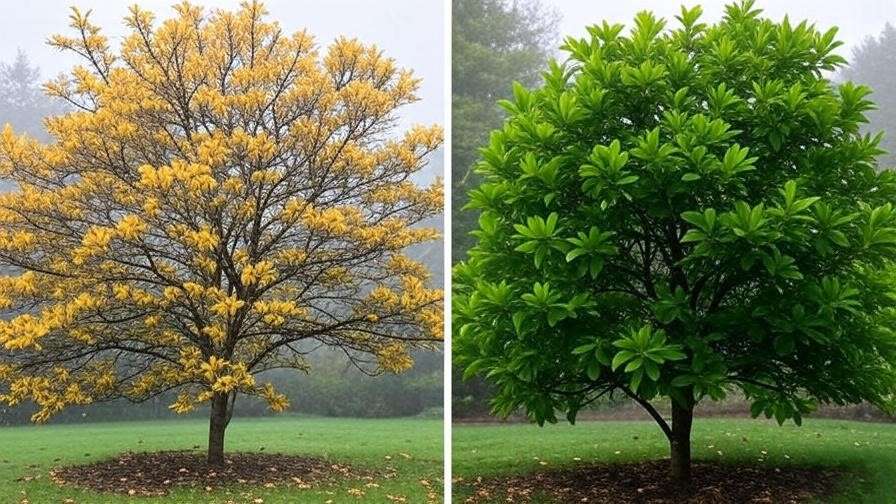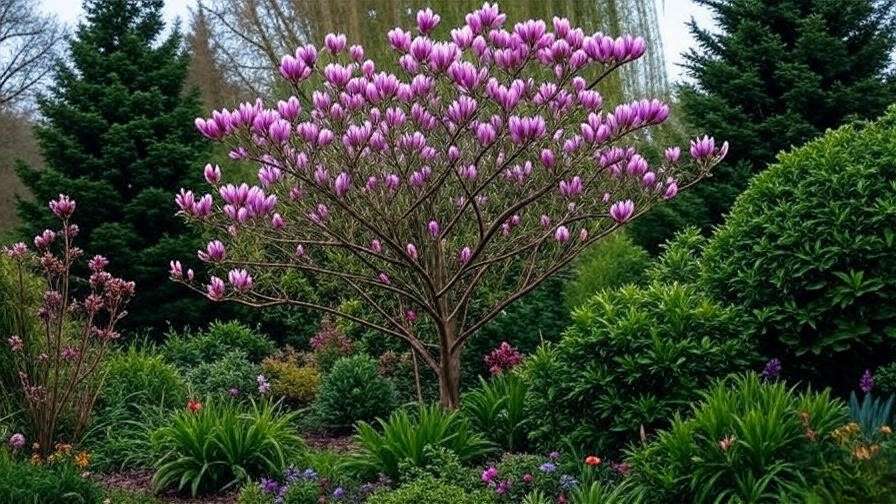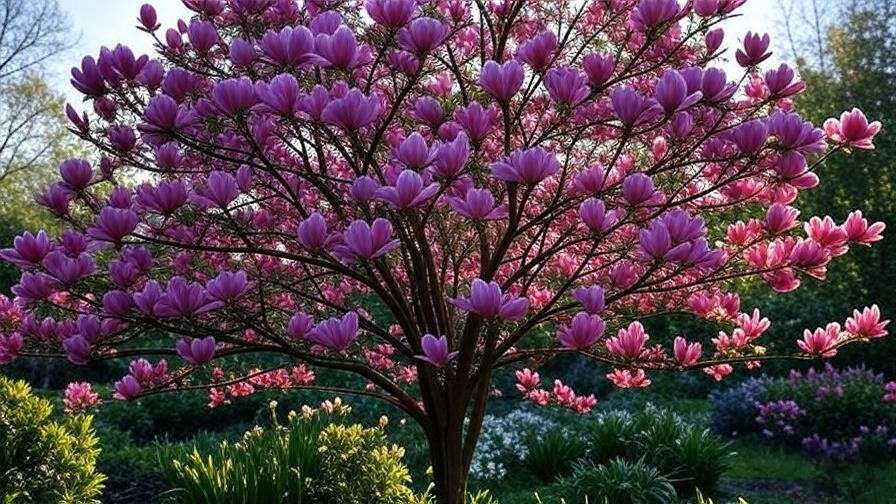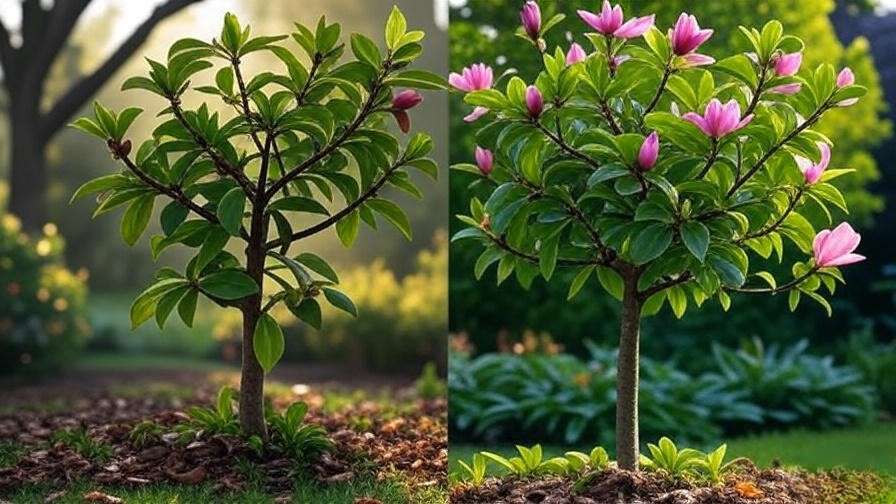Imagine your garden bursting with vibrant, pinkish-purple blooms, their sweet fragrance wafting through the air each spring. The galaxy magnolia tree, a stunning hybrid known for its show-stopping flowers, can make this dream a reality. Whether you’re a novice gardener or a seasoned plant enthusiast, this comprehensive guide will empower you to grow and care for a galaxy magnolia tree with confidence. From planting tips to troubleshooting common issues, we’ll cover everything you need to ensure your tree thrives, delivering breathtaking blooms year after year. Backed by horticultural expertise and practical experience, this article is your ultimate resource for cultivating a healthy, vibrant galaxy magnolia. 🌿
What is the Galaxy Magnolia Tree? 🌟
Origins and Characteristics
The galaxy magnolia tree (Magnolia ‘Galaxy’) is a hybrid marvel, born from a cross between Magnolia liliiflora and Magnolia sprengeri. Introduced by the U.S. National Arboretum, this ornamental tree is celebrated for its large, fragrant flowers that bloom in shades of pinkish-purple with delicate white interiors. Growing to a manageable height of 15-25 feet with a spread of 10-15 feet, it’s perfect for small to medium-sized gardens. Its upright, pyramidal growth habit and glossy green leaves add year-round appeal, making it a standout in any landscape.

Why Choose a Galaxy Magnolia Tree?
Why opt for a galaxy magnolia? Its vibrant spring blooms, low maintenance needs, and adaptability to various climates (USDA hardiness zones 5-9) make it a top choice. Unlike the larger Southern Magnolia, the galaxy magnolia’s compact size suits urban gardens, while its prolific flowering outshines smaller varieties like the Star Magnolia. “The galaxy magnolia’s combination of hardiness and floral beauty makes it a favorite for gardeners seeking elegance without excessive upkeep,” says Dr. Jane Horton, a horticulturist with over 20 years of experience. Its disease resistance and ability to thrive in diverse soil types further enhance its appeal.
Planting Your Galaxy Magnolia Tree 🌱
Choosing the Right Location
To ensure your galaxy magnolia tree flourishes, selecting the perfect spot is crucial. This tree thrives in full sun to partial shade, requiring at least 6 hours of sunlight daily for optimal blooming. Well-drained, slightly acidic soil (pH 5.5-6.5) is ideal, though it tolerates loamy or clay soils with proper preparation. Test your soil’s pH using a home kit, available at most garden centers, and amend with sulfur if it’s too alkaline. Choose a location sheltered from strong winds to protect delicate blooms and young branches.

When and How to Plant
The best time to plant a galaxy magnolia is early spring or fall, when cooler temperatures promote root establishment. Follow these steps for success:
- Dig the Hole: Make it twice as wide and as deep as the root ball.
- Prepare the Soil: Mix in organic compost or aged manure to boost fertility.
- Plant the Tree: Place the tree so the root crown is level with the soil surface.
- Backfill and Water: Fill the hole, tamp down gently, and water thoroughly.
- Mulch: Apply a 2-3 inch layer of organic mulch, keeping it 2 inches from the trunk.
Pro Tip: Adding a handful of bone meal to the planting hole encourages strong root growth. 🪴
Selecting a Healthy Tree
When purchasing a galaxy magnolia, choose a healthy specimen from a reputable nursery. Look for a tree with a sturdy trunk, vibrant green leaves, and no signs of wilting or yellowing. Check the roots: They should be white and firm, not brown or mushy. Avoid root-bound trees, as they may struggle to establish. “A healthy start is key to long-term success,” notes arborist Mark Reynolds. Inspect the tree for pest damage or disease before buying to avoid future headaches.
Essential Care Tips for a Thriving Galaxy Magnolia 🌼
Watering Requirements
Proper watering is vital, especially for young galaxy magnolia trees. For the first two years, water deeply once or twice weekly, ensuring the soil stays consistently moist but not waterlogged. Mature trees are more drought-tolerant but benefit from deep watering during prolonged dry spells. A good rule of thumb: Provide 1 inch of water per week, adjusting for rainfall. In summer, check the soil’s top 2 inches; if dry, it’s time to water. Use a soaker hose for even distribution and to avoid wetting the foliage, which can invite fungal issues.
Fertilizing for Optimal Growth
Fertilizing supports vigorous growth and abundant blooms. Apply a balanced, slow-release fertilizer (e.g., 10-10-10 NPK) in early spring before flowering. Spread it evenly around the drip line, avoiding direct contact with the trunk. For young trees, use half the recommended dose to prevent over-fertilization, which can cause leaf burn or excessive foliage at the expense of flowers. Organic options like composted manure or fish emulsion are excellent alternatives. Avoid fertilizing after mid-summer to prevent new growth that’s vulnerable to frost.
Pruning and Shaping
Pruning enhances the galaxy magnolia’s shape and encourages blooming. The best time to prune is late winter or early spring before new growth begins. Remove dead, damaged, or crossing branches to improve air circulation and light penetration. Shape the tree to maintain its natural pyramidal form, but avoid heavy pruning, as magnolias heal slowly. Use clean, sharp shears to prevent disease spread. Expert Tip: “Light, strategic pruning promotes flowering without stressing the tree,” advises Reynolds. Always sanitize tools with rubbing alcohol between cuts. ✂️
Mulching and Soil Care
Mulching is a game-changer for galaxy magnolias. A 2-3 inch layer of organic mulch, such as bark chips or pine straw, retains moisture, regulates soil temperature, and suppresses weeds. Apply mulch in a ring around the tree, leaving a 2-inch gap around the trunk to prevent rot. Replenish annually in spring. Regularly check soil drainage; if water pools after rain, consider raised planting or amending with sand to improve drainage. Healthy soil equals a happy tree!
Protecting Your Galaxy Magnolia Tree from Pests and Diseases 🛡️
Common Pests
Galaxy magnolias are relatively pest-resistant but can attract scale insects, aphids, and spider mites. Scale appears as small, waxy bumps on branches, while aphids cluster on new growth, causing leaves to curl. Spider mites, often active in dry conditions, leave fine webbing and stippled leaves. Combat pests with neem oil or insecticidal soap, applied early in the morning. For severe infestations, consult a professional arborist. Regular inspection and maintaining tree vigor through proper care are your best defenses.
Diseases to Watch For
Fungal diseases like powdery mildew, verticillium wilt, and leaf spot can affect galaxy magnolias. Powdery mildew appears as white patches on leaves, while verticillium wilt causes wilting and branch dieback. Leaf spot presents as dark spots with yellow halos. Prevent these by ensuring good air circulation, avoiding overhead watering, and removing fallen leaves promptly. If disease strikes, apply a fungicide labeled for magnolias and follow package instructions. A case study from a Virginia nursery showed that improving drainage and airflow resolved a powdery mildew issue within one season.
Winter Protection
In colder climates (zones 5-6), protect young galaxy magnolias from frost and heavy snow. Wrap the trunk with burlap or tree wrap to shield against freezing temperatures. Apply an extra 2 inches of mulch around the base to insulate roots. For young trees, consider a temporary windbreak using stakes and burlap. If frost damage occurs, prune affected branches in spring and monitor recovery. Mature trees are hardier but still benefit from mulch during harsh winters.
Encouraging Vibrant Blooms Year After Year 🌺
Factors Affecting Bloom Quality
The galaxy magnolia tree’s spectacular blooms are its crowning glory, but achieving consistent, vibrant flowers requires attention to key factors. Sunlight is critical—insufficient light (less than 6 hours daily) can reduce flowering significantly. Ensure your tree is planted in a spot with ample sun exposure. Soil nutrients also play a role; deficiencies in nitrogen, phosphorus, or potassium can lead to sparse blooms. Regular soil testing every 2-3 years helps identify nutrient gaps. Lastly, pruning practices matter—over-pruning or pruning at the wrong time (e.g., late summer) can remove next season’s flower buds. Stick to light pruning in late winter for best results.
Seasonal Care Checklist
To keep your galaxy magnolia blooming vibrantly, follow this seasonal care guide:
- Spring: Fertilize with a balanced, slow-release fertilizer (10-10-10 NPK) as buds form. Prune lightly to remove deadwood. Monitor for pests like aphids and treat early with neem oil. Water consistently to support new growth. 🌸
- Summer: Deep water during dry spells, ensuring 1 inch of water weekly. Check for signs of stress, such as wilting leaves, and adjust care. Reapply mulch if it has thinned. ☀️
- Fall: Prepare for dormancy by reducing watering as temperatures cool. Apply a fresh 2-inch layer of mulch to insulate roots. Remove fallen leaves to prevent fungal issues. 🍂
- Winter: Protect young trees from frost with burlap wraps or extra mulch. Avoid fertilizing or pruning during dormancy to prevent stress. ❄️
Companion Planting Ideas
Enhance your galaxy magnolia’s beauty with strategic companion planting. Low-growing plants like azaleas, hostas, or ferns complement its upright form and add texture to your garden. Azaleas, with their colorful blooms, create a stunning spring display alongside the magnolia’s flowers. Hostas provide lush, green ground cover, thriving in the partial shade cast by mature trees. For pest deterrence, consider planting marigolds or lavender nearby, as their scents repel aphids and other insects. Ensure companion plants have similar soil and water needs to avoid competition. “Pairing magnolias with shade-tolerant perennials creates a balanced, low-maintenance garden,” notes landscape designer Emily Carter.
Troubleshooting Common Galaxy Magnolia Problems 🧰
Yellowing Leaves
Yellowing leaves can signal several issues. Nutrient deficiency, particularly nitrogen or iron, is a common cause—test your soil and apply a fertilizer suited to the deficiency (e.g., iron chelate for chlorosis). Poor drainage can also lead to yellowing, as waterlogged roots suffocate; ensure the planting site drains well or amend with sand. Overwatering is another culprit; check soil moisture before watering and adjust to maintain consistent but not soggy conditions. If yellowing persists, consult a local extension service for a tailored diagnosis.

Lack of Blooms
Nothing’s more disappointing than a galaxy magnolia that won’t bloom. Common causes include:
- Insufficient sunlight: Relocate container-grown trees or thin nearby foliage to increase light exposure.
- Improper pruning: Cutting too late in the season removes flower buds. Prune only in late winter or early spring.
- Young tree age: Trees under 3-5 years may not yet be mature enough to bloom heavily. Be patient and maintain consistent care.
If these factors are addressed and blooming still lags, consider a phosphorus-rich fertilizer to boost flower production. “Patience is key with young magnolias—they often need a few years to hit their stride,” says Dr. Horton.
Drooping or Wilting
Drooping or wilting leaves indicate stress, often from root rot, drought, or transplant shock. Check soil drainage; if water pools, improve it with organic matter or relocate the tree. For drought stress, increase watering frequency, ensuring deep soaking. Transplant shock is common in newly planted trees—maintain consistent moisture and avoid fertilizing for the first 6 months. If wilting persists, inspect roots for rot (brown, mushy roots) and trim affected areas, then replant in well-drained soil. A recovering tree may take a season to regain vigor, so monitor closely.
Galaxy Magnolia in Landscape Design 🎨
Incorporating into Your Garden
The galaxy magnolia tree shines as a focal point in any garden. Plant it in a front yard for curb appeal or near a patio for up-close enjoyment of its blooms. Its compact size makes it ideal for urban spaces or mixed borders. Pair it with evergreen shrubs like boxwood or holly to create year-round structure. For a layered look, underplant with shade-loving perennials like bleeding hearts or astilbes. Ensure the tree has enough space to grow without crowding, as its canopy spreads 10-15 feet at maturity.

Seasonal Interest
The galaxy magnolia offers year-round beauty:
- Spring: Showy pinkish-purple blooms steal the spotlight, attracting pollinators like bees. 🐝
- Summer: Lush, glossy green leaves provide a verdant backdrop.
- Fall: Leaves turn a subtle yellow, adding warm tones to the garden.
- Winter: The tree’s elegant branch structure adds architectural interest, especially in snowy landscapes.
This multi-season appeal makes it a versatile choice for dynamic garden designs.
Real-Life Examples
A homeowner in North Carolina transformed their small backyard by planting a galaxy magnolia as a centerpiece, surrounded by low-growing junipers and daylilies. The result? A vibrant spring display that transitioned into a lush summer retreat. Another example from a Virginia botanical garden showcases a galaxy magnolia paired with rhododendrons, creating a stunning woodland effect. “Magnolias are perfect for adding drama without overwhelming a space,” says Carter, who designed the Virginia display.
Frequently Asked Questions (FAQs) ❓
How fast does a galaxy magnolia tree grow?
The galaxy magnolia has a moderate growth rate, adding 1-2 feet per year under ideal conditions. It reaches maturity in 10-15 years, achieving its full height of 15-25 feet.
Can I grow a galaxy magnolia in a container?
Young galaxy magnolias can be grown in large containers (at least 15 gallons) for a few years, but their size and root system make them better suited for in-ground planting long-term. Ensure excellent drainage and regular watering if container-grown.
What’s the difference between galaxy magnolia and other magnolias?
The galaxy magnolia stands out for its hybrid vigor, compact size, and prolific pinkish-purple blooms. Compared to the Southern Magnolia (larger, evergreen), it’s better for smaller spaces. Unlike the Star Magnolia (smaller flowers), it offers more dramatic blooms.
How do I propagate a galaxy magnolia?
Propagation is challenging for home gardeners and best left to professionals. It’s typically done via softwood cuttings in summer or grafting onto rootstock. Success rates are low without specialized equipment, so purchasing nursery stock is recommended.
Expert Tips for Long-Term Success 🌟
- Soil Amendments: Mix in aged compost annually to maintain soil fertility. For acidic soils, add elemental sulfur sparingly to keep pH in the 5.5-6.5 range.
- Sustainable Practices: Use drip irrigation to conserve water and apply organic pest controls like neem oil to minimize environmental impact.
- First-Time Grower Checklist:
- Test soil pH before planting.
- Choose a sunny, sheltered location.
- Water consistently for the first two years.
- Prune lightly in late winter.
- Monitor for pests and diseases early.
“Consistency is the secret to a thriving magnolia. Small, regular efforts yield big rewards,” advises Reynolds.
Conclusion
Growing a galaxy magnolia tree is a rewarding journey that transforms your garden with its stunning blooms and elegant form. By choosing the right location, providing consistent care, and addressing issues promptly, you’ll enjoy vibrant flowers and healthy growth for years to come. Whether you’re planting your first tree or adding to an established garden, this guide equips you with expert-backed strategies to succeed. Share your galaxy magnolia experiences in the comments, and explore our related articles on ornamental tree care for more inspiration! 🌿














